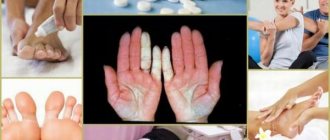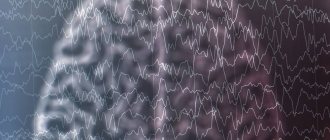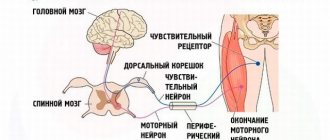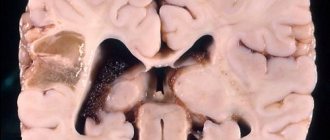Types of numbness
When parts of the body go numb, the body reacts in this way to harmful environmental conditions. Sometimes the symptom manifests itself in more complex situations, during a stroke or atherosclerosis. Therefore, it is necessary to determine the types of ailment, when it relates to the body’s normal reaction to irritation and requires therapy; the participation of specialists is rarely required.
Let's figure out what kind of numbness you don't need to go to the hospital for:
- Transient, lasting several minutes without repetition.
- After prolonged sitting or lying down.
- Minor tingling, goosebumps.
When you need specialist advice:
- Symptoms recur from time to time.
- Do not stop for a long period.
- In addition to tingling, it is accompanied by a burning sensation, uncontrolled urination, and gagging.
Numbness of the first type often occurs due to prolonged immobility of the limbs. At first, the temperature may change, tingling appears after interaction with cold. If numbness does not disappear after massage procedures, you need to contact a specialist.
Causes and types of numbness on the left side of the body
Numbness is a complete or partial loss of sensation in any part of the body. The cause of this condition is damage to the nerve endings. A symptom may indicate the development of a certain pathology.
Types of numbness
Depending on the type of numbness, this may be a normal reaction of the body to an external stimulus or a symptom of a serious disease: atherosclerosis or stroke.
Numbness on the left side that does not require medical attention:
- after being in a certain position for a long time;
- short-term, which last a few minutes and do not repeat;
- mild tingling, goosebumps.
Numbness of the left side of the body, which requires consultation with a specialist:
- does not go away for a long time;
- the symptom recurs periodically;
- tingling is accompanied by vomiting, uncontrolled urination, and burning.
Numbness in the first case is a consequence of prolonged immobility of the limbs. Tingling may occur with a sudden change in temperature. If after a massage the numbness of the right or left side does not go away, you should consult a doctor.
Causes
Numbness of any part of the body indicates a disruption of the nervous system. Paresthesia is a serious cause for concern. The exception is a quickly passing tingling sensation or severe hypothermia.
Causes of numbness on the left side:
- Radicular syndrome. Inflammation due to radiculopathy or radiculitis. Compression of the nerve roots in the spine disrupts blood circulation in the vessels, which is manifested by pain and numbness, which can be observed on both the right and left sides.
- Intervertebral hernia. The limbs and fingertips lose sensation due to compression of the spinal nerves. Accompanied by pain in the back.
- Polyneuropathy. Characteristic of patients suffering from diabetes. High glucose levels contribute to nerve and peripheral vascular damage. Characterized by symmetrical numbness.
- Raynaud's or Tunnel syndrome. With sedentary work, obesity or metabolic disorders, the fingers and hands lose sensitivity.
- Stroke. Speech suddenly becomes slow, facial muscles become numb, and the person is unable to smile. The motor function of the left side of the body is impaired. Depending on the degree of brain damage, paralysis can be complete or partial. The condition requires immediate hospitalization. With timely treatment, the unpleasant symptom goes away in a couple of weeks.
- A benign or malignant tumor in the brain or spine causes pain, numbness, or discomfort on the left side. The tumor compresses nerve endings and blood vessels, reducing the sensitivity of the limbs.
- Taking medications can cause numbness. If a symptom is present, stop therapy or change the medication.
Certain diseases may be accompanied by numbness in one or another part of the body.
- Limbs. Loss of sensation in the legs or arms is acquired or hereditary. Paresthesia in these parts of the body is a symptom of stroke, heart attack, atherosclerosis, ischemia, and osteochondrosis.
- Right part. Symptoms indicate the presence of inflammation and systemic diseases. The right side is numb due to radiculitis, carpal tunnel syndrome, tumor, joint deformation, stroke, sclerosis, diabetes.
- Left side of the face. Paresthesia in this part of the body is accompanied by burning, swelling and tingling. It can be caused by damage to the central nervous system, VSD, facial paralysis, stroke, triangular neuralgia.
- Fingers. Loss of sensitivity, accompanied by pain and change in color of the limbs, is characteristic of vasospasm. The condition is observed in osteochondrosis, Raynaud's syndrome, scleroderma, and intervertebral hernia.
- Mouth and tongue. The cheeks, chin, lip and tongue become numb due to jaw injuries and dental problems. Numbness of the mucous membrane of the mouth and pharynx is characteristic of spasm of nerve tissue, candidiasis, burns, glossalgia.
After surgery, partial or complete loss of sensation in a certain area of the body may occur. The causes of this condition are determined by a specialist after examining the patient. If necessary, additional diagnostics are prescribed.
Numbness after surgery is a consequence of:
- damage to nerve endings;
- circulatory disorders;
- hernias
The doctor will prescribe therapy, determining the cause of paresthesia and its nature. As a rule, physiotherapy, medications or traditional medicine prescriptions are prescribed as treatment.
Every person has experienced this unpleasant symptom during sleep. The condition is characterized by loss of control of motor function.
For paresthesia to disappear, it is necessary to change position and rub the numb part of the body to restore blood supply.
If these measures do not help, then the cause of temporary paralysis is certain pathologies: atherosclerosis, osteochondrosis, arthritis, polyneuropathy, sclerosis, stroke and brain tumors. Regular paresthesia occurs due to a lack of microelements, B vitamins, and pregnancy.
Often paresthesia is accompanied by other symptoms that are characteristic of certain pathologies.
- Painful sensations. Pain is always alarming. Unpleasant sensations can affect the area of the limbs, shoulder blades, neck, and ribs. In combination with numbness - harbingers of a heart attack or stroke.
- Goosebumps. After being in an uncomfortable position for a long time, a slight tingling sensation may appear in the left hand. If the sensation occurs regularly, it is a symptom of dehydration, hormonal imbalance, heart attack, vitamin B deficiency, Raynaud's syndrome, hernia or tumor in the spine.
- Burning. Numbness accompanied by this unpleasant symptom is characteristic of osteochondrosis, fibromyalgia, intercostal neuralgia, polyneuropathy, and poisoning with toxic substances.
Diagnostics
Numbness of the torso on the left is a serious symptom of dysfunction of the nervous system. If numbness occurs regularly, you should consult a specialist who will prescribe a series of tests to make a diagnosis:
- Study of anamnesis. The doctor will listen to the patient, get acquainted with the symptoms and find out about the presence of chronic diseases.
- If stroke or ischemia is suspected, CT and MRI of the head are prescribed.
- The quality of blood circulation, the presence of blood clots, blockages and cholesterol plaques will allow you to evaluate ultrasound of blood vessels and identify the causes of blood circulation disorders.
- If an intervertebral hernia, osteochondrosis, or other pathologies of bones and cartilage are suspected, an MRI of the back is prescribed. The study will determine the condition of muscle and bone tissue, as well as detect tumors or inflammation.
In addition to hardware tests, tests are required that will allow you to see a more complete picture of the patient’s health and prescribe the most effective treatment.
Causes
Numbness often occurs as a result of compression of nerve fibers or poor blood circulation in tissues. This happens when a person does not change his position for a long time.
CNS disorders manifest themselves in a similar way. Unilateral paresthesia is considered an alarming sign. To eliminate this condition, it is necessary to carry out diagnostic procedures to determine what specifically provoked them.
Prevention
To date, there is no specific prophylaxis to prevent the development of numbness. Experts recommend leading a healthy lifestyle, following a diet, playing sports and giving up bad habits. This approach is the basis for the prevention of most neurological and vascular diseases.
Numbness of the right arm and leg most often appears due to neurological disorders. Sometimes the cause is diseases of the blood vessels or the musculoskeletal system. Treatment is symptomatic and very effective in the initial stages.
To prevent disorders of the cervical spine and improve blood circulation in the right limb, you can use specially designed exercises:
- You need to sit on a chair, grab your shoulders with your hands and move your joints in a circle with successive repetitions 10-15 times.
- You need to cross your fingers on your right and left hands, bring them to the back of your head. The elbows are kept at the same level, the joints are brought together and straightened to the sides about 15 times.
- You need to take a vertical position, place your legs at shoulder level, and place your hands on your hips. You need to turn your body left and right 10 times.
- The arms rise upward as you inhale, then gradually lower as you exhale.
- The starting position is the same. You need to turn your head, then tilt it towards your shoulders 10 times.
- You need to rotate your head clockwise, then in the opposite direction. It is better to perform the exercise in a sitting position, while monitoring your well-being.
- There is no need to walk in place, gradually raise your arms and hips.
- Hands rise up, straighten to the sides, then down and so on 10 times.
The duration of such gymnastics is about 10 minutes. If possible, you should perform exercises up to 3 times a day. Elementary exercises not only relieve numbness, but will also serve as an excellent prevention of neck osteochondrosis, and may also have a positive effect on the body.
Symptoms
Numbness of the limbs often occurs. Signs may appear temporarily or persistently and over a long period of time. Sometimes pain is felt, dizziness, weakness, movement and speech function are difficult, and pathologies develop.
When the limbs become numb due to pinching of nerve fibers or impaired blood supply, therapy is not used. In this situation, it is enough to change your position and rub the numb area. Often, numbness occurs due to hypothermia, in order to restore sensitivity, you need to warm up.
In other situations, numbness in the body does not disappear after changing posture or massaging. You should consult a doctor if this occurs constantly and is accompanied by other signs. It is necessary to be examined in a situation where numbness is felt after an injury.
After operation
Numbness of the skin after surgery is expressed by a decrease or complete loss of sensitivity in a certain area of the body (no need for an operating room).
The causes of paresthesia are determined by the doctor. The patient is examined, palpated, and, if necessary, undergoes additional diagnostics.
Postoperative numbness occurs as a result of:
- Damage to nerve endings;
- Blood supply disorders;
- Hernias.
If symptoms occur, immediately seek help from your doctor. How to restore sensitivity
Treatment measures are prescribed by a doctor. Initially, the cause of numbness and its nature (temporary, permanent, partial, complete) are determined.
For treatment, the following are indicated: physiotherapy, medications, folk recipes. In case of complete loss of sensitivity (paralysis), the treatment method depends on the causes.
Causes
We list the diseases that cause numbness:
- Radicular syndrome often causes paresthesia, with numbness occurring in the fingers or part of the upper limb, sometimes a burning sensation occurs, worsening at night.
- Polyneuropathy occurs in patients with diabetes when, after a metabolic disorder, blood vessels and nerve fibers begin to deteriorate due to prolonged abnormally high concentrations of glucose. In such situations, numbness occurs symmetrically on both limbs.
- Stroke is the most dangerous cause of this condition. Damage to the brain structures responsible for the functioning of individual parts of the body causes numbness. After a stroke, one side always fails, depending on the hemisphere in which the hemorrhage occurred. Other signs include motor dysfunction.
- Neoplasms in the brain can compress organ tissue and impair normal functioning. Symptoms appear gradually.
- Multiple sclerosis is a chronic disorder of the central nervous system, which is characterized by compression of fragments of nerve tissue. As a result, numbness appears, sensitivity worsens, and vision problems.
Causes of numbness include Raynaud's disease, in which the blood supply to nerve tissue deteriorates, atherosclerosis, or the consequences of surgery in various parts of the body.
What pathologies can be suspected when a nagging pain occurs in the left side
In the half of the abdominal cavity we are considering there are the following organs:
- Sections of the large and small intestines;
- Stomach;
- Spleen;
- Genitourinary organs;
- Pancreas;
- Lumbar spine.
If a pulling pain occurs from the back and intensifies with movement, it is worth considering a pathology of the spine.
A nagging pain in the left side of women below the navel indicates possible problems with the genital organs, most often the ovaries. In men, it often occurs with inflammation of the scrotum and prostate.
If you experience nagging discomfort on the left side at the level of the navel in front, you can think about pathologies of the intestines, spleen, and pancreas. Behind - about problems with the kidney. Occasionally, nagging pain in the left side of the abdomen appears in healthy people, for example, during heavy physical exertion, in women during pregnancy.
Diseases of the digestive organs
A nagging pain on the left side in front can accompany pathologies of the digestive organs. Most often these are problems with the intestines, and one such common problem is irritable bowel syndrome.
Another reason may be related to the pancreas (pancreatitis), in which aching and pulling discomfort may radiate to the back area.
To suspect these diseases, you need to pay attention to the presence of other characteristic symptoms:
- Nausea;
- Vomit;
- Increased gas formation;
- Diarrhea;
- Constipation.
Pathologies of the genitourinary system
A nagging pain in the left side behind in men and women can occur with inflammatory pathologies of the kidney.
At the same time, the following characteristic symptoms are observed:
- Urinary problems;
- Discomfortable sensations when trying to urinate;
- Change in urine color;
- Deterioration of general condition.
In this case, the unpleasant sensations that arise do not depend on physical activity.
Nagging pain on the left side in women is usually associated with gynecological diseases, which include:
- Chronic inflammatory pathologies of the ovary;
- Tumor processes in the left appendage;
- Menstrual irregularities;
- Torsion of the cyst pedicle on the left;
- Sexually transmitted infections.
In men, such discomfort may be associated with vesiculitis, prostatitis, or orchitis.
Nagging pain in the side of the lower abdomen in men and women also occurs with left-sided inguinal hernias and sprains. If left untreated for a long time, inflammatory conditions of the reproductive organs in men and women can lead to infertility.
Spine pathologies
A nagging pain in the left side from the back can be caused by various pathologies and injuries of the spine. At the same time, discomfort increases with active movements and physical activity. Along with it, a feeling of numbness may occur in the corresponding lower limb.
It happens that pain in the lower back occurs in healthy people, and then disappears on its own. Then the problem is most likely an uncomfortable position during sleep, an uncomfortable bed, as well as prolonged sitting at work.
Another reason that causes nagging pain in the left side behind may be inflammation of the muscle tissue in this area. Discomfortable sensations are accompanied by the appearance of compactions or swellings, upon palpation of which the pain intensifies.
Pregnancy
The symptom of nagging pain in the lower left side during pregnancy at various stages is quite common.
This symptom occurs both normally and in pathology. It all depends on the duration, intensity of the discomfort and the presence of concomitant ailments. In early stages of pregnancy, as a rule, this sign is associated with pathological situations and may indicate the occurrence of:
- Progesterone deficiency;
- Frozen pregnancy;
- Detachment of the amniotic sac;
- Ectopic pregnancy.
In the later stages, the appearance of such a symptom is usually physiological and is associated with the rapid growth of the uterus and stretching of its ligaments. In this case, the pain is not intense, short-lived, goes away after rest, there are no other symptoms. Otherwise, discomfort may be associated with emerging pathologies. If you experience pain of any nature and intensity during pregnancy at different stages, you should in any case inform your doctor about it.
When to Seek Emergency Help
In some cases, the resulting symptom of nagging pain in the left side requires urgent measures.
Such situations include:
- The nagging pain appeared suddenly and increases over time;
- Increased temperature and deterioration in general condition appear;
- Along with painful discomfort, nausea and repeated vomiting occur;
- Loose stools with blood appear;
- Sharp nagging pain in the left side;
In any case, you should not be patient and wait for everything to go away on its own. Even with mild nagging pain, it is better to consult a doctor. First, you should go to a therapist, who will then, if necessary, refer you to the right specialist and prescribe the necessary examinations.
So, the symptoms described above should help you understand the reasons that cause nagging pain in the left side, front and back. Now you know how important it is to contact a specialist on time.
Do not forget that a correct diagnosis can only be made after passing the necessary tests and examinations. Therefore, only a doctor can find the cause of the pain that appears and prescribe effective treatment.
Limbs
Numbness on the left side of the body occurs most often in middle-aged people. At the same time, a burning sensation or coldness is felt. Causes may be congenital or acquired. Problems with sensitivity indicate the appearance of disorders of the nervous system, heart and blood vessels.
Paresthesia appears in the following conditions:
- Heart attack.
- Ischemic disorders.
- Osteochondrosis.
- Brain hemorrhage.
- Problems with blood vessels in the head.
The ischemic disorder causes persistent numbness in the left limb. At the same time, pain in the sternum and heart is detected. The sensitivity of the left hand and forearm worsens. After a heart attack, my arms and left leg go numb. Trying to eliminate the symptoms on your own is undesirable; you need to seek help from a doctor.
You'll have to call an ambulance or go to the hospital. In case of such problems, a comprehensive examination by cardiologists and other specialists is carried out. With the help of modern equipment, the reason why the body goes numb is determined.
After this, the doctor prescribes treatment, which involves taking medications and following general recommendations:
- Quitting alcohol and smoking.
- Strong coffee is eliminated from the diet.
- Hot food and cereals are included in the diet.
- It is recommended to play sports, run, exercise in the pool, skiing.
Prevention stabilizes the blood supply system, ensuring uninterrupted blood flow to the arms and legs.
A number of tests and diagnostic methods
You should not self-medicate under any circumstances, since numbness is a serious signal of a disruption in the functioning of the nervous system. When visiting a doctor, a specialist conducts a number of studies:
- Interview and anamnesis study. This will allow the doctor to become familiar with complaints and symptoms, and the medical history will make it possible to understand the presence or absence of chronic diseases, which will help establish a diagnosis.
- An MRI of the back is prescribed if suspicion falls on osteochondrosis, intervertebral hernia and other osteochondral pathologies. The procedure will allow you to determine the condition of bone and muscle tissue, as well as see the presence of inflammatory processes or neoplasms.
- Vascular ultrasound will allow you to determine in real time the quality of blood circulation, the presence of embolism, that is, blood clots, cholesterol plaques and other blockages that impair blood circulation.
- MRI and CT of the brain should be performed if a stroke, pre-stroke condition, cerebral ischemia and other pathological processes are suspected.
The video will introduce the first and main symptoms of a cerebral stroke:
In addition to studies using special equipment, mandatory urine and blood tests are carried out, which describe a complete picture of the patient’s health status. Also, a detailed blood test will familiarize the doctor with the number of blood cells, ESR and other indicators, which will allow you to choose the most effective course of treatment.
Right side
Numbness on the right side of the body is not studied as an independent disease. Often, symptomatic manifestations indicate inflammation in the body and systemic disorders.
As an exception, hypothermia or deterioration of skin sensitivity with prolonged compression is considered.
Let's look at the reasons:
- Hernia in the spine.
- Neoplasms on the back.
- Stroke.
- Joint damage.
- Bad heredity.
- Sclerosis.
Sensitivity in the right side worsens after increased concentrations of heavy metals or diabetes. Therapy for paresthesia will be determined by the causes of the disease, which manifests itself after some examinations. If the problem with skin sensitivity is caused by prolonged compression, uncomfortable position or radicular syndrome, you will need massage and gymnastics.
To stretch small muscles, use:
- To improve the work of the hand, balls or walnuts should be placed in the palm of your hand, covered with the other hand and performed in a circular motion.
- The feet can be kneaded with warm, firm peas.
When paresthesia is provoked by other pathologies, therapy is determined by the attending physician. Therapy is performed using medications.
When you need specialist help
If numbness of the left limb occurs regularly, persists for longer than 10-15 minutes and is accompanied by severe pain, the patient requires the help of a specialist. A dangerous symptom is numbness due to a sharp change in local temperature, when the left leg suddenly becomes hot or cold. These symptoms are a sign of a systemic disease that should be treated by a qualified physician.
It is necessary to seek medical help for injuries, especially if any joint is swollen or the surrounding skin has acquired a red or bluish tint. Intervention is also necessary for severe frostbite, which can result in tissue necrosis.
You should not delay your visit to the clinic if numbness has become a common occurrence. Advanced diseases of the musculoskeletal system, which in most cases manifest themselves in this way, can lead to disability.
If numbness in the hand occurs regularly or for a long time, the help of a specialist is required.
Doctors can help determine the cause of loss of sensitivity after examination:
- Cardiologist;
- Therapist;
- Neurologist.
This is due to the possibility of numbness of the hand occurring due to the development of diseases in the area of their specialization.
If there is no specific suspicion of the cause of the symptom, you need to contact your local physician, who will prescribe general procedures. This is required to identify the area where the pathology occurs and refer you to the right specialist.
Pain in the heart area that accompanies numbness of the arm or part of it requires the attention of a cardiologist. Without additional symptoms, an initial consultation with both a local therapist and a neurologist is possible.
Based on the results of the examinations, it may be necessary to contact such doctors as:
- Orthopedist;
- Surgeon;
- Rehabilitologist;
- Osteopath.
Having figured out why the right arm and leg are numb, let’s look at the accompanying symptoms. This disease rarely manifests itself in isolation; usually the clinical picture consists of several signs:
- Unpleasant sensations in the right arm or leg - usually appear after physical exertion or prolonged work. Patients note a feeling of heaviness, squeezing, followed by the development of numbness;
- Pain – occurs after an attack, when sensitivity returns to the muscles. Numbness is characterized by burning, aching or squeezing pain in the palms and feet. If a nerve is pinched, the symptom is noted in the affected area (buttock, armpit);
- Paresthesia is a short-term loss of sensation in the palms and soles. These sensations resemble “pins and needles”; some patients describe them as “puffing up of the skin”;
- A decrease in heart rate is characteristic of vascular pathologies. A decrease in pulsation is recorded on the radial artery or in the popliteal fossa;
- Pale skin – observed in the area of the forearms and legs, hands and feet.
Symptoms of numbness in the right arm and leg
In what situations does numbness indicate illness?
Some people need to learn to understand when it is best to pay more attention to their health. You have to sound the alarm when numbness of the body is observed for a long time and often. In this case, people lose control of their limbs and become unable to move them.
It is necessary to take into account the characteristics of the skin. When people's fingers go numb or their skin changes color, they need to see a doctor as soon as possible. It is difficult for patients to talk when sensitivity in the face and chin deteriorates. Swelling occurs periodically.
When sensation worsens around the waist, it becomes difficult to control bowel movements and urination. In such situations, you need to consult a doctor for therapy.
Such signs are not always a cause for concern when a person does not change position for a long time. If it’s cold outside and gloves don’t help, your fingers get very cold, sensitivity and the ability to control the function of your limbs deteriorate. Numbness should not lead to negative thoughts if a person simply rests his legs or rests his arm. But if the sensitivity of the limb does not resume after some time, you need to contact specialists for help.
On the left side of the face
Symptoms of paresthesia of the left side of the face are manifested by tingling of the skin, swelling, and burning.
- Low levels of B vitamins, lack of sodium, calcium;
- Stress and depression;
- Migraines, attacks of fear;
- Excess oxygen in blood vessels;
- Uncomfortable head position, prolonged sitting;
- Hypothermia.
If a feeling of numbness occurs regularly, the patient does not need to seek help from a medical facility.
The causes of left-sided facial numbness are other pathologies:
- Damage to the central nervous system;
- Facial nerve paralysis;
- Trinitarian neuralgia;
- Stroke;
- Dystonia.
If sensory loss occurs systematically, a medical examination will be required.
Paresthesia is a dangerous symptom. If numbness on the left side of the face does not go away on its own, massage does not alleviate the symptoms, you need to make an appointment with a doctor or call an ambulance.
The specialist will examine the patient and conduct a diagnosis. Based on the results of the examination, the cause of the loss of sensitivity in the facial muscles will be revealed. Depending on the pathology, therapeutic measures will be prescribed.
Numb fingers
When people suffer from loss of sensation in the fingers or experience severe pain, there is a change in the color of the limbs, in such a situation the issue of vasospasm is considered. A similar condition is typical for Raynaud's syndrome, intervertebral hernia, scleroderma, and osteochondrosis.
Suspicions of osteochondrosis arise if not only the limb goes numb, but also the head begins to hurt; therapy is determined by a specialist. When loss of sensation occurs in the little or ring fingers, neuropathy occurs.
Goosebumps
Goose bumps on the left hand appear as a result of a long stay in an uncomfortable position. The blood vessels contract, blood does not flow to the palms, and a tingling sensation appears.
If this condition occurs in rare cases and does not last long, then there is nothing to worry about. This tingling sensation is considered acceptable.
If the sensation of “pins and needles” on the left hand appears systematically, there is a possibility of developing various pathologies:
- Dehydration of the body;
- Hormonal changes;
- Vitamin B deficiency;
- Tumor or hernia in the spine;
- Raynaud's syndrome;
- Stroke or heart attack.
Face and head
Patients often worry about numbness in the head and facial muscles. Such symptoms are rarely caused by the body’s natural response to external factors.
A temporary decrease in sensitivity in the face or back of the head occurs in the following situations:
- After sleep, when the head was in an unnatural position.
- Reading, working on a computer and many other activities require holding your head statically in one position.
- The effects of panic attacks, neuroses.
Pathological conditions include stroke, which is expressed by numbness, while the skin rarely becomes numb on the right.
Numbness of the face may indicate the following situations:
- Trigeminal neuritis.
- Migraine.
- Neurosis.
- VSD.
- Slerosis.
- Damage to nerve fibers.
- Cerebrovascular disorders.
Deterioration in the sensitivity of the tongue, chin, and cheeks can be caused by dental disorders and jaw injuries. If there are disorders in the cervical spine during the occurrence of VSD attacks or pressure changes, the head and skin in some places may become numb.
Disorders of the tongue, pharynx, and oral mucosa occur with the following disorders:
- Glossalgia.
- Hot food burns.
- Candidiasis.
- Spasm of nerve tissue.
Numbness of varying degrees of localization appears due to nervous overstrain and stressful situations. Insect bites can cause sensitivity problems.
How does the malaise appear?
If the left side is numb, the reasons may be problems in the passage of impulses along the nerve processes. Loss of skin sensitivity occurs from disorder or damage to nerve fibers. The area of the integumentary tissue does not receive the signal and loses sensitivity.
There are five factors for the appearance of illness that determine the nature of the disease. If you know about part of the loss of sensitivity, you can name the cause of the symptom:
- The signaling is stopped by the brain. Such cases are serious. This causes the left side of the face or the rest of the body to go numb.
- Disturbances in the functioning of the nervous system. Pinched nerves make it difficult for signals to reach parts of the body. For this reason, different parts of the body are changed - cheeks, chin, fingers, hips, knees.
- Circulatory disorders. With pinching, oxygen oil enters the vessels. This is what causes the left side to go numb.
- Muscle cramps complicate the passage of impulses along nerve endings.
- Components that negatively affect the skin. For example, consuming large amounts of alcohol can cause your fingers to go numb. Workers in professions that require contact with chemicals (shop workers, builders, metallurgists) are more susceptible to loss of sensitivity than others. In these situations, numbness may be due to dangerous components - arsenic, lead, mercury, solvents. This problem also occurs among visitors to the dentist’s office. When the filling material penetrates the tooth canal, there is a risk of loss of sensitivity of the lips, tongue, nose, and cheeks.
These are the main factors why the left side of the body goes numb. Whatever the cause of this phenomenon, timely treatment prescribed by a doctor is necessary.
Treatment
The therapeutic technique is determined individually in all situations. Traditional and non-traditional methods of therapy are used. Exercise therapy is carried out for radicular syndromes to improve one’s condition; doctors also recommend massage, reflexology and physiotherapy. Numbness of the body in diabetes is treated by endocrinologists, drugs and diet are prescribed, and lifestyle is adjusted.
Numbness of parts of the body on the right side requires increased physical activity and adjustments to the diet. Nicotine, alcohol, peppery and salty foods have a harmful effect on the condition of the circulatory system and cartilage tissue. You need to dress according to the weather so that hypothermia does not occur; diseases will be treated in time without becoming chronic.
Drug therapy involves the use of:
- Medicines that reduce pain and inflammation.
- Medications that reduce spasms.
- Drugs that aggravate the conduction of nerve impulses.
- Medicines that improve the functioning of the blood supply system.
- Medicines that stabilize blood pressure.
To prevent negative reactions of the body you need:
- Take frequent breaks from work that involves being in the same body position, and do exercises.
- Mattresses and pillows must be of high quality.
- Nutrition needs to be improved to reduce weight and strengthen the diet with vitamins.
- Perform therapeutic exercises that strengthen joints and intervertebral discs, promoting blood circulation.
There is no need to eliminate numbness caused by complex diseases and folk recipes. Such symptoms can be stopped, but the disease will not be cured. As a result, the symptoms will be much brighter and more severe.
Recommendations
It is better not to treat numbness using folk remedies. They have a superficial effect, only temporarily eliminating discomfort. The problem may worsen in the future, so it is advisable to seek help from a specialist.
Numbness is considered a symptom of possible health problems. You should not despair and give up. This problem is being solved. You need to get tested and make an appointment with a specialist. It is important to spend more time on your body: exercise, be often in nature. With a healthy lifestyle, there will be no room for diseases.
Why do goosebumps occur?
To combat such a disorder, you first need to determine the cause leading to this condition. Often people's arms and legs go numb. Such signs appear temporarily or remain stable. In rare situations, such symptoms cause pain and weakness. The arms and legs are more difficult to move, the head is dizzy, and it is difficult for the person to talk.
If your limbs become numb due to pinched nerve endings or blood flow problems, you may need to change your body position to relieve symptoms. Sometimes arms and legs go numb during cold spells, so people are advised to keep warm.
Such numbness occurs for several reasons:
- When people's fingers or some parts of their hands go numb all the time, radicular syndrome may occur, which includes radiculitis, caused by interruptions in the vascular system or mechanical compression of nerve fibers in the spine and spinal cord. Sometimes with such numbness, a burning sensation is felt in the hands.
- Polyneuropathy appears in patients with diabetes. This occurs because the sugar level in the patient’s blood rises, leading to disease of the nerve fibers, blood vessels, and lymph nodes. Patients complain that the sensitivity of the limbs is deteriorating.
- In case of serious health problems, numbness appears only on the right or left. The cause of this disease is stroke. Only during a stroke does the patient feel numbness on the left or right. Sometimes the symptoms spread to the face.
During sleep
During sleep, every person experienced a feeling of numbness. The condition is characterized by loss of motor control over various parts of the body.
If this does not happen, then the causes of temporary paralysis lie in the presence of other pathologies:
- Osteochondrosis;
- Polyneuropathy;
- Stroke;
- Brain tumors;
- Sclerosis;
- Arthritis;
- Atherosclerosis.
A lack of vitamins B12, B9, B6 and microelements in the body can cause regular paresthesia.
If you experience regular numbness during sleep, you should seek help from a specialist. To determine the causes of paresthesia, a comprehensive examination is carried out: ultrasound, computed tomography, x-ray, blood tests. Then treatment is selected.
Body numbness is a serious cause for concern. There is no need to self-treat. The doctor will identify the true cause of paresthesia and prescribe the correct treatment.
A fairly common phenomenon is when some part of the body goes numb. This is an inconvenience for anyone. When the left side of the body goes numb, the reasons may be health problems. If this happens constantly and suddenly, then medical attention is needed.
Paresthesia is a loss of skin sensitivity, or tingling. The disease can be temporary or permanent. Some people are alarmed by such symptoms, while others may not pay attention to it. But sometimes such sensations are symptoms of serious illnesses.
Why does one side of the body feel cold?
Most often, one hand freezes due to poor circulation in the blood vessels passing through it.
It is believed that body temperature is maintained due to the release of heat during metabolic processes in the cells of the body, and metabolism and its intensity depend, among other things, on how many substances for this exchange are supplied to the cells with blood - one of the main carriers of various substances , with which they move inside our body. This, of course, is a very simplified picture of the functioning of our body and is only suitable as a very general diagram.
Of course, there may be many reasons why the body produces less heat than usual, but a local decrease in metabolic rate can occur precisely as a result of disruption of blood flow in a freezing organ - from an accidentally “pinched” blood vessel to a reduction in the cross-section of blood vessels from -for deposits of the same cholesterol inside blood vessels or some other disease.
If there are no external reasons, for example, “squeezing” the hand, then you can try to measure the pressure on both hands using an automatic tonometer. If there is noticeably less pressure on the hand that is freezing, then you most likely have a problem with blood circulation in it.
By the way, the feeling that the hand is freezing may be false - for example, due to a decrease in skin sensitivity, which can occur, in particular, when the skin is damaged or as a result of a neurological disease.
Most often, people get cold due to poor blood circulation. Apparently the capillaries are clogged. You definitely need to take an x-ray and see what’s there. Also, if you had a hand injury, then this can also explain it. (I have the same situation due to injury) Be sure to go for a consultation. This is not something to joke about.
Due to circulatory disorders, such a relapse occurs.
Why does one hand of a person get cold, while the other is warm and the person himself is not frozen?
Most likely the person has insufficient blood supply to one limb. The reason can be completely different, from a congenital feature to some kind of vascular diseases, so you should definitely be examined by a specialized specialist.
In addition, it is also worth checking with a neurologist, there may be a problem in the nerves.
There is a circulatory disorder.
Perhaps blood vessels are pinched somewhere. This is unlikely to go away on its own; you definitely need to see a doctor.
source
Reasons why the left side of the body goes numb
In people with certain types of pathologies, the left side of the body goes numb. The causes of this condition and accompanying symptoms are described below in the article. In this case, tingling occurs on the skin, sometimes pain, and mobility becomes difficult.
Types of numbness
When parts of the body go numb, the body reacts in this way to harmful environmental conditions. Sometimes the symptom manifests itself in more complex situations, during a stroke or atherosclerosis. Therefore, it is necessary to determine the types of ailment, when it relates to the body’s normal reaction to irritation and requires therapy; the participation of specialists is rarely required.
Let's figure out what kind of numbness you don't need to go to the hospital for:
- Transient, lasting several minutes without repetition.
- After prolonged sitting or lying down.
- Minor tingling, goosebumps.
When you need specialist advice:
- Symptoms recur from time to time.
- Do not stop for a long period.
- In addition to tingling, it is accompanied by a burning sensation, uncontrolled urination, and gagging.
Numbness of the first type often occurs due to prolonged immobility of the limbs. At first, the temperature may change, tingling appears after interaction with cold. If numbness does not disappear after massage procedures, you need to contact a specialist.
Causes
Numbness often occurs as a result of compression of nerve fibers or poor blood circulation in tissues. This happens when a person does not change his position for a long time.
CNS disorders manifest themselves in a similar way. Unilateral paresthesia is considered an alarming sign. To eliminate this condition, it is necessary to carry out diagnostic procedures to determine what specifically provoked them.
Symptoms
Numbness of the limbs often occurs. Signs may appear temporarily or persistently and over a long period of time. Sometimes pain is felt, dizziness, weakness, movement and speech function are difficult, and pathologies develop.
When the limbs become numb due to pinching of nerve fibers or impaired blood supply, therapy is not used. In this situation, it is enough to change your position and rub the numb area. Often, numbness occurs due to hypothermia, in order to restore sensitivity, you need to warm up.
In other situations, numbness in the body does not disappear after changing posture or massaging. You should consult a doctor if this occurs constantly and is accompanied by other signs. It is necessary to be examined in a situation where numbness is felt after an injury.
Limbs
Numbness on the left side of the body occurs most often in middle-aged people. At the same time, a burning sensation or coldness is felt. Causes may be congenital or acquired. Problems with sensitivity indicate the appearance of disorders of the nervous system, heart and blood vessels.
Paresthesia appears in the following conditions:
- Heart attack.
- Ischemic disorders.
- Osteochondrosis.
- Brain hemorrhage.
- Problems with blood vessels in the head.
The ischemic disorder causes persistent numbness in the left limb. At the same time, pain in the sternum and heart is detected. The sensitivity of the left hand and forearm worsens. After a heart attack, my arms and left leg go numb. Trying to eliminate the symptoms on your own is undesirable; you need to seek help from a doctor.
You'll have to call an ambulance or go to the hospital. In case of such problems, a comprehensive examination by cardiologists and other specialists is carried out. With the help of modern equipment, the reason why the body goes numb is determined.
After this, the doctor prescribes treatment, which involves taking medications and following general recommendations:
- Quitting alcohol and smoking.
- Strong coffee is eliminated from the diet.
- Hot food and cereals are included in the diet.
- It is recommended to play sports, run, exercise in the pool, skiing.
Prevention stabilizes the blood supply system, ensuring uninterrupted blood flow to the arms and legs.
Right side
Numbness on the right side of the body is not studied as an independent disease. Often, symptomatic manifestations indicate inflammation in the body and systemic disorders.
As an exception, hypothermia or deterioration of skin sensitivity with prolonged compression is considered.
- Hernia in the spine.
- Neoplasms on the back.
- Stroke.
- Joint damage.
- Bad heredity.
- Sclerosis.
Sensitivity in the right side worsens after increased concentrations of heavy metals or diabetes. Therapy for paresthesia will be determined by the causes of the disease, which manifests itself after some examinations. If the problem with skin sensitivity is caused by prolonged compression, uncomfortable position or radicular syndrome, you will need massage and gymnastics.
- To improve the work of the hand, balls or walnuts should be placed in the palm of your hand, covered with the other hand and performed in a circular motion.
- The feet can be kneaded with warm, firm peas.
When paresthesia is provoked by other pathologies, therapy is determined by the attending physician. Therapy is performed using medications.
In what situations does numbness indicate illness?
Some people need to learn to understand when it is best to pay more attention to their health. You have to sound the alarm when numbness of the body is observed for a long time and often. In this case, people lose control of their limbs and become unable to move them.
It is necessary to take into account the characteristics of the skin. When people's fingers go numb or their skin changes color, they need to see a doctor as soon as possible. It is difficult for patients to talk when sensitivity in the face and chin deteriorates. Swelling occurs periodically.
When sensation worsens around the waist, it becomes difficult to control bowel movements and urination. In such situations, you need to consult a doctor for therapy.
Such signs are not always a cause for concern when a person does not change position for a long time.
If it’s cold outside and gloves don’t help, your fingers get very cold, sensitivity and the ability to control the function of your limbs deteriorate.
Numbness should not lead to negative thoughts if a person simply rests his legs or rests his arm. But if the sensitivity of the limb does not resume after some time, you need to contact specialists for help.
Numb fingers
When people suffer from loss of sensation in the fingers or experience severe pain, there is a change in the color of the limbs, in such a situation the issue of vasospasm is considered. A similar condition is typical for Raynaud's syndrome, intervertebral hernia, scleroderma, and osteochondrosis.
Suspicions of osteochondrosis arise if not only the limb goes numb, but also the head begins to hurt; therapy is determined by a specialist. When loss of sensation occurs in the little or ring fingers, neuropathy occurs.
Face and head
Patients often worry about numbness in the head and facial muscles. Such symptoms are rarely caused by the body’s natural response to external factors.
Source: https://mostech-group.ru/nelzya/pochemu-merznet-odna-storona-tela/











